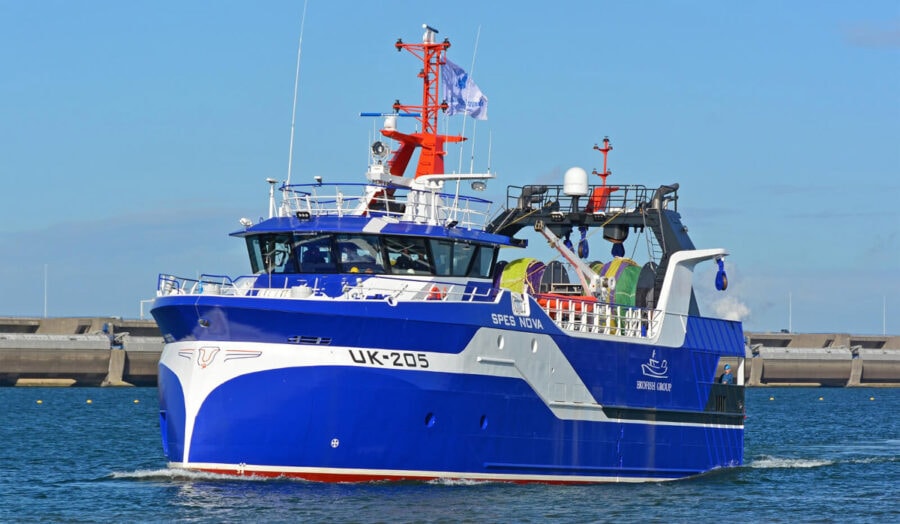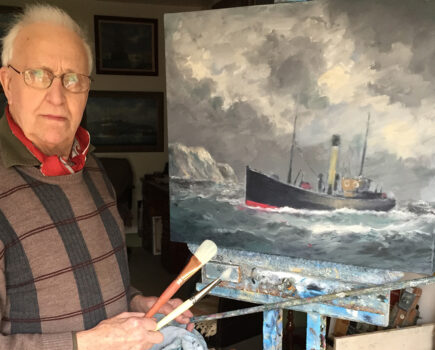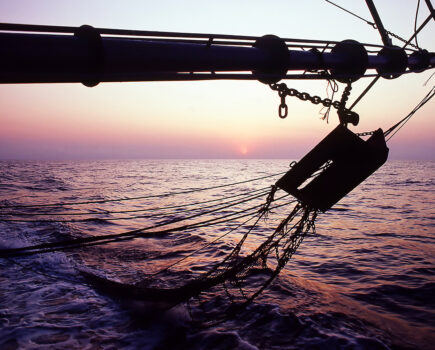With decarbonisation now a global necessity, Seafish assistant economics researcher Kelly Beatson explores how the fishing industry can move towards that goal
Fully electric boats first saw a boom much earlier than you might think. Well over 100 years ago, when the only other power option was steam, electric battery-powered motors were in their first stages of invention. By 1890, electric boat activity was on the rise, with small, fully electric, non-tidal passenger boats being very popular. Most of the large boatbuilders on the Thames had experience in building, fitting and hiring out electric boats.
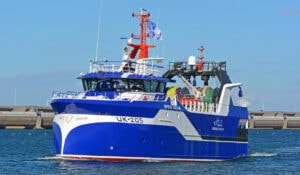
The 31m diesel-electric hybrid twin-rig trawler/fly-shooter Spes Nova UK-205 was built at Damen Maaskant Shipyards in 2019. (Photo: Damen Shipyards Group)
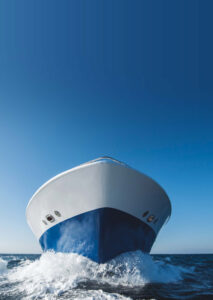
Slender design is one important element of improving fuel efficiency, but in the UK the pressure to keep smaller vessels under the 10m mark works against this.
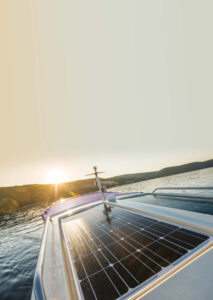
Solar panels and wind turbines are now common on yachts, and could be scaled up to suit some fishing boats.
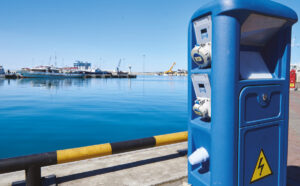
Electric charging points in harbours would need to become standard in order to enable widespread conversion.

The UK Clean Maritime Plan set targets for reducing emissions from all maritime industries.

The 11m Karoline M-82-H, one of the world’s first hybrid electric fishing vessels, has a Corvus lithium polymer energy storage system. (Photo: Corvus Energy)
Around the same time, internal combustion technologies were also making a breakthrough. In the subsequent decades, the development of more powerful oil engines, ease of refuelling and the technological push of the First World War meant that oil-fuelled engines soon took over as the drivers of choice.
The UK’s future looks set for decarbonisation, so what part can the fishing industry play in helping the UK meet these goals?
Environmental awareness
The theory behind the greenhouse effect goes back as far as 1824. Later, in 1896, a Swedish scientist came up with the idea that the burning of fossil fuels may cause global warming by increasing carbon dioxide (CO2) in the atmosphere.
It took a while for the evidence to build, but by the 1980s the consensus was beginning to form, leading the World Meteorological Organisation to establish the Intergovernmental Panel on Climate Change in 1998.
Since then, emission reduction technologies have become an active area of research, and many regions around the world have implemented increasingly stringent emissions standards.
All vessels, including fishing, are currently regulated by MARPOL 73/78 Protocol of 1997 (Annex VI) – Regulations for the Prevention of Air Pollution from Ships.
Decarbonisation: emission-free future
Decarbonisation of ships is already in the pipeline. In July 2019, the UK published its Clean Maritime Plan, making it one of the first countries to publish a national action plan. The plan is described as the UK’s routemap to clean growth for the maritime sector and pathway to zero-emission shipping.
In 2018, the International Maritime Organisation adopted a strategy to reduce CO2 emissions across international shipping by at least 40% by 2030, and 70% by 2050, compared to 2008.
Although initially it appears to be focused on shipping, the UK government’s Clean Maritime Plan also states that: “By 2025, we expect that all vessels operating in UK waters are maximising the use of energy-efficiency options. All new vessels being ordered for use in UK waters are being designed with zero-emission propulsion capability.”
For many years, maritime industries have been left out of much of the debate about global emissions. With interest in shipping now increasing, it’s looking likely that the decarbonisation spotlight will soon be shining on fishing boats too. Here we look at innovations from across marine industries which may help to reduce emissions from fishing.
The average lifespan of a fishing boat is 25 to 30 years. To futureproof purchases, anyone thinking of acquiring a new boat soon would be sensible to consider the implications of future carbon strategies on the fishing industry.
Electric vessels
There may be options to completely eliminate the need for fuel oil from fishing boats. In 2015, the Karoline, one of the world’s first hybrid electric fishing vessels, was revealed in Norway. The Karoline hosts a Corvus lithium polymer energy storage system integrated with Siemens BlueDrive PlusC marine propulsion system.
The Karoline’s 30 lithium polymer batteries are charged overnight by plugging into the port’s power supply. This provides enough power so that the 11m vessel can run for 10 hours on the battery alone. The Karoline also features a back-up diesel generator for emergencies or higher-power activities.
Energy storage systems such as that onboard the Karoline can lead to fuel savings of around 25%. This, whilst simultaneously reducing emissions by 25-40%, makes energy storage systems an investment for the future.
Since then, the larger 31m Dutch twin-rig MDV-1 Immanuel was developed, showing that hybrid technology is being utilised in a range of fishing vessel types. A similar 31m combination twin-rig trawler/fly-shooter Spes Nova UK-205, built at Damen Maaskant shipyards in the Netherlands, went through North Sea fishing trials in October 2019.
There are further benefits to the electric or hybrid systems other than fuel savings and lower emissions. Electric systems use up less space onboard, freeing up space for more catch. They are also much quieter and produce far less vibration, creating a more pleasant working environment and reducing marine noise pollution.
But switching to electric would mean skippers have to learn a new set of skills. Macduff Ship Design offers a full range of naval architecture, marine consultancy and design services to owners and shipyards. While discussing vessel advancements, Ian Ellis, managing director at Macduff, mentioned that skippers often end up doing a lot of the vessel maintenance but might not be familiar with electric engines. “They’re very comfortable servicing and repairing their diesel engines, and any changes to engine design would require a very steep learning curve that may not seem as feasible for vessels that don’t have a designated engineer.”
Diesel-electric hybrid vessels
Since the diesel electric retrofit of the Queen Elizabeth II in 1988, electric propulsion has seen a marked rise in both technologies and in uptake across various marine sectors. With the aim of reducing emissions and noise pollution, Norway retrofitted its first diesel electric hybrid ferry Ampere in 2015. Other similarly converted diesel electric ferries have since appeared in Denmark, Sweden and Finland. Of course, the electricity source also needs to be low or zero carbon to have an effect on emissions.
Currently, renewables make up about 40% of total UK electricity production. This is much lower than the Scandinavian nations, especially Norway, which produces so much that it also exports it.
Ampere’s conversion was considered a massive success, with a 95% reduction in CO2 and 80% reduction in operating costs. Unsurprisingly, the potential cost savings are attracting a lot of orders, not just for the conversion of existing diesel-powered ferries but also for new electric ferries. Fjord1, a major Norwegian transport conglomerate which operates 75 ships, has placed an order with the Havyard Group to build a fleet of battery-electric ferries. Whilst existing electric ferries tend to be conversions, these new vessels are built to be electric.
Alternative fuels
Alternative fuels include any fuel type other than conventional fossil fuels, and they can include biodiesel or bio-alcohol, gases like hydrogen or ammonia, or even compressed air. A 2006 Australian government report suggested that biodiesel and pure vegetable oil were the most promising alternative fuels for the fishing industry given the existing infrastructure, available space on fishing boats and safety considerations.
So far, the major sources of biofuels are plant-based sugars and oils. It is technically possible to produce marine biofuels that are compatible with the existing marine engines, pipelines and bunker infrastructure, and it is also possible to blend sustainable biofuels with other ship fuels, reducing total emissions. In 2006, the Grimsby-based trawler Jubilee Quest was adapted for a trial comparing diesel with vegetable oil. The result was 80% carbon mitigation without compromising pulling power.
Vegetable oil hasn’t had commercial success in the fishing industry, because despite lower emissions, there’s no cost saving to be made by switching, and converting the engine can be costly.
Hydrogen as a fuel source emits zero CO2, zero sulphur dioxide and only negligible nitrogen oxide. However, its use as a replacement for traditional diesel fuel still requires research and development, and there are still safety issues associated with storing hydrogen.
Ammonia emits similarly negligible emissions, and it has already been used successfully in land-based installations such as buses. When used as a duel-fuel option with diesel, it can yield promising CO2 reductions. Compared to hydrogen, ammonia does not require high-pressure, low-temperature storage, and is a widely traded commodity, being predominately used as a fertiliser. All in all, this makes ammonia a very competitive option.
One main barrier to alternative fuels for the fishing industry is bunkering and the availability of fuels, particularly in smaller harbours and more remote regions around the coast. Changing fuels is not something vessel owners can realistically consider until suitable fuelling infrastructure is in place. On the other hand, in order to persuade harbours and ports to introduce these facilities, the demand from vessels may need to arise first.
Technological measures
Slender design and propulsion improvement devices (PIDs) were found to have the largest potential fuel savings. PIDs are modifications made to the hull or propeller.
The Wolfson Unit, an engineering consultancy based in the University of Southampton, principally works on the design and testing of hull shape and hydrodynamics. Its main goal is to reduce resistance and consequently reduce fuel consumption. It commented that ‘with increasing waterline length comes reduced resistance and increased efficiency’.
Further complementing improvements in hull shape, coating technologies have seen advancements in anti-fouling paints that limit corrosion and biological growth that roughen the hull and propeller.
As a rule of thumb, longer, narrower vessels with smoother surfaces below the waterline use fuel more efficiently.
Various ship designers in the UK commented that the uptake of advancements in hull shape and coatings has seen a rise in more recent years; however, the categories of current UK vessel licensing are very influential on the design of vessels. Vessel licences are defined by length, and are split into under-10m and over-10m categories.
Ian Ellis of Macduff Ship Design commented: “The current system means a lot of vessels are being built wide and deep to create as much space as possible in a vessel that can be licensed in the under-10m category.”
The future
There are many promising measures that are already being utilised to achieve emission reductions and fuel savings across the marine sectors.
 Electric vessels have seen a recent revival. Both conversions and new builds are showing very promising reductions in fuel use, emissions, vibrations, noise and operational costs.
Electric vessels have seen a recent revival. Both conversions and new builds are showing very promising reductions in fuel use, emissions, vibrations, noise and operational costs.
Initial outlay cost is still relatively high; however, electric battery technology is currently an area of high investment, particularly in the transport sector, and technologies are continually improving. As more industries and businesses get onboard, a virtuous circle begins.
As demand increases, costs decrease; with increased demand from the fishing industry, the shift to electric may become more economically viable.
Aside from electric technology, alternative fuels can offer reductions in emissions. Uptake is currently limited by infrastructure, in particular bunkering, but research and development is ongoing.
Advancements in the hydrodynamic design of new vessels also has a promising future; however, changes in current licensing may be needed to open up the possibilities for changing vessel shapes.
In the meantime, there are many operational and strategic changes to fishing activity that are already being utilised and can bring immediate fuel and emissions reductions.
For more information on this topic, contact: Stuart.McLanaghan@seafish.co.uk
This article is reproduced by kind permission of Seafish from the sixth edition of Quay Issues – a publication informed by Seafish’s annual survey of the UK fishing fleet.
Work on the next edition of Quay Issues will begin in early 2021, ahead of release in the spring.

